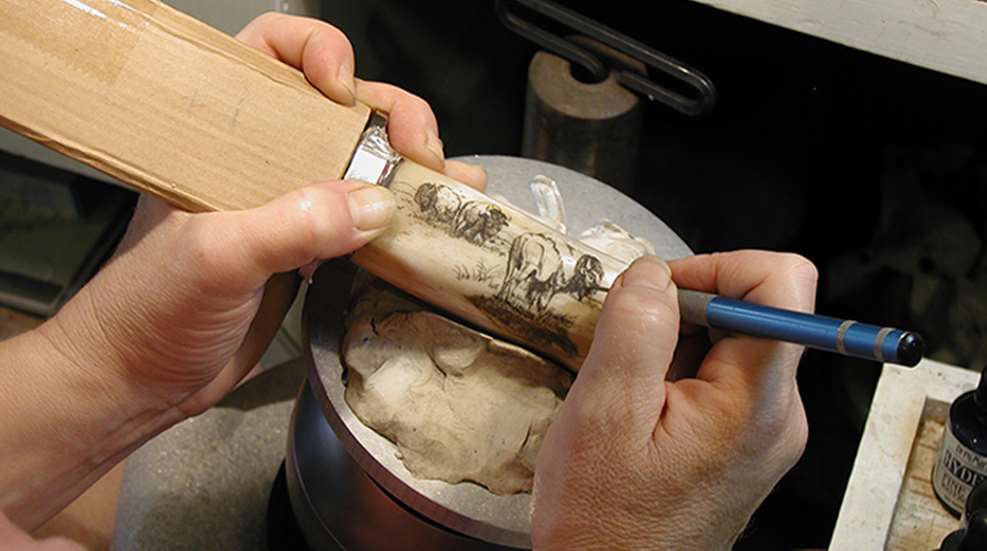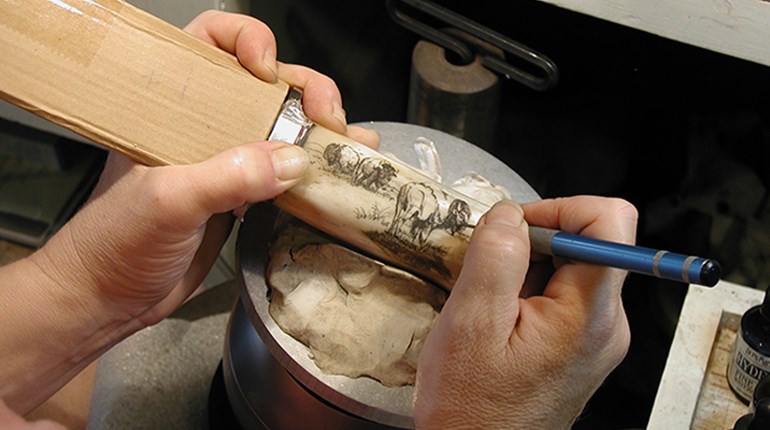
It wasn't until she was a teenager that Sandy Brady discovered scrimshaw, the art of scratching-or etching-a design onto ivory or bone objects. She fell in love with it, and thus began her “cool job" as a scrimshander, which is what scrimshaw artists are called. Today, Brady's engraved gun grips, knives, billiard balls, cue sticks and jewelry can be found in collections around the world.
The Beginning
“I've always been involved in art," says Brady, who recalls taking art classes at the Toledo Museum of Art during her elementary school years. “Whether drawing, painting or throwing pots, I loved it all."
But it was an almost-by-chance introduction to scrimshaw that sparked what would become her life's passion. A local company wanted to make scrimshaw pieces to sell to jewelry stores and the public, so they asked Brady's high-school art teacher for recommendations. Brady was one of six, only two of whom were hired.
“I didn't know anything about scrimshaw until they interviewed me and gave a quick demonstration," says Brady. Immediately after, she was handed some ivory, inscription tools and ink and told to re-create what she'd just seen. As the interviewer left the room, Brady gazed in bewilderment at the ivory. “I was terrified," she admits. But she gamely set to work, and when the interviewer came back, Brady had done enough to impress. She was hired on the spot.
The Road to Success
The young artist was hooked. “It was the coolest thing I had ever worked at," she says. So the opportunity to learn scrimshaw and get paid for it was a dream come true. “I've been scratching out a living ever since," she says with a laugh.
Because no scrimshaw classes were offered at that time, Brady developed most of her scrimshaw technique through trial and error. As she continued her artistic education at the University of Toledo and the Toledo Museum of Art, she took classes in drawing, painting and printmaking, with emphasis on anatomy and the human form.
Thirty years later, Brady still creates and sells her scrimshaw pieces. She also teaches scrimshaw classes, attends trade shows and gives short talks, seminars and demonstrations across the country. Her daughter Emily, who is studying for a degree in art, works part-time in Brady's home studio.
The Workday
Brady has long since established her working routine. “I try to start by 9:00," she says, “but I'm flexible since I'm self-employed." First, she likes to check e-mails and take care of business details-the phone calls and paperwork that are her least favorite part of the job. From there, it's on to sketching, which she does by hand. Finished sketches are scanned into her computer and re-sized so they are the exact size she needs to transfer to the ivory.
“Then I sit and scrimshaw most of the day," says Brady of the task she describes-somewhat surprisingly-as her second favorite part of the job.
“I really do have a drive to make art," she says, “to draw and be creative. So many people hate going to work every day, but I love going to work."
Part of the fascination is working with interesting materials. “Scrimshaw is best on natural materials," explains Brady. “I have the opportunity to have mammoth tusks and mammoth teeth." This type of ivory is thousands of years old and comes from extinct animals, so there are no problems getting it, quite legally, from places like Alaska or Siberia.
Brady's favorite part of the job is teaching, which allows her to leave the studio where she spends so much time working alone. “I love the interaction," she explains. “Each class I teach, I learn something from the students. They come up with things I would never have thought of. I'm teaching them, but I'm learning something from them, too."
Past and Future
Much of Brady's work is done on commission. About 10 years ago, shortly after the Gulf War, she received an invitation to do the artwork on the handle of a knife for General Norman Schwarzkopf, Jr. Brady listened carefully as she was told Schwarzkopf was a West Point graduate, his nickname was “the Bear," and that four stars on the knife guard would symbolize his rank of four-star general. The design on the handle was up to her.
She attended the lunch at which the finished knife was presented to Schwarzkopf. “He was a humble man," recalls Brady. “I could see how he would inspire his troops. He was gracious and caring, and it was an honor to meet him and then-President [George H.W.] Bush."
Another past commission was for a one-of-a-kind pool cue featuring scenes from the movie Hustler, starring Paul Newman. The cue was signed by the actor and auctioned off at a charity auction to benefit the Hole in the Wall Gang Camp, a free camp for children ages 7 to 15 with cancer and serious blood diseases. The winning bid was $30,000.
As to what's next, Brady will continue her scrimshaw work-both commissioned and for general sale. She'll attend her usual eight to 12 trade shows a year, and she's working on a second how-to-do-scrimshaw DVD, this one in color.
Scrimshaw and You
Scrimshaw is an exacting art. When you work on a small scale, “if you're off by a hair's width, it will show," explains Brady. But if your passion is art, a career in this centuries-old art form might be worth exploring.
You need drawing skills, including an understanding of basic anatomy, and attention to detail. You should have good eye-hand coordination, know how to work with color and enjoy working alone for much of the day. You must be able to manage your own work schedule because you'll most likely be working for yourself. You also need some business knowledge, such as how to keep financial records and how to market yourself, as well as people skills for dealing with clients.
If this combination of skills and activities sounds like it's right down your alley, scrimshanding-as it is for Brady-may be the “cool job" for you.




































